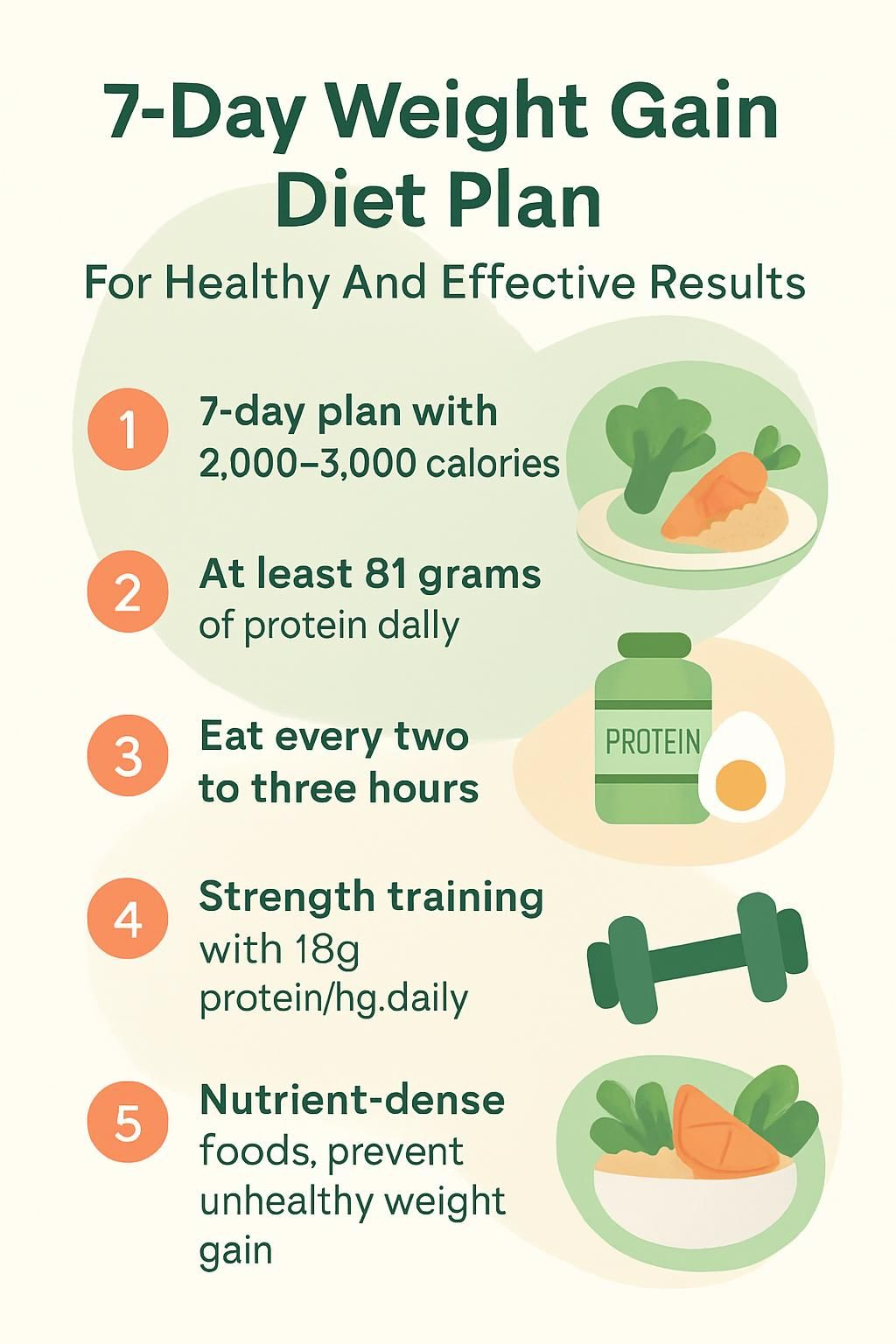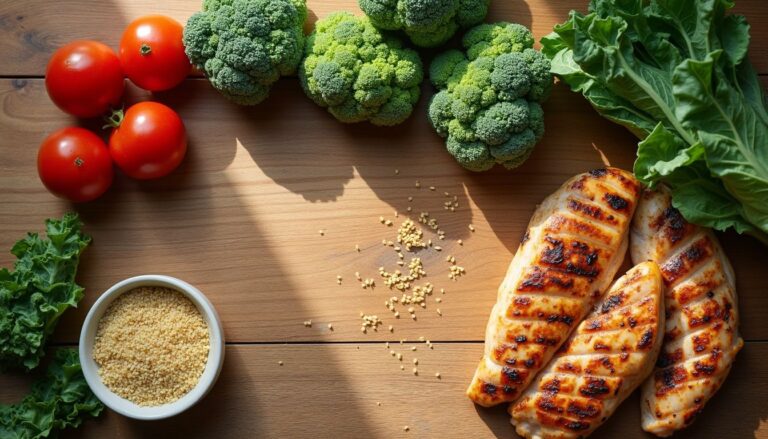7-Day Weight Gain Diet Plan For Healthy And Effective Results
Our Nutrition Assistant AI Suite will transform your body. You will lose fat, get toned, and build muscle. Gain confidence and optimal health.
Healthy weight gain can feel tough, especially after illness or with a low appetite. A structured weight gain diet plan built on nutrient-dense foods helps you add muscle while limiting excess fat. Research from major public health groups supports a balanced approach that pairs smart calories with strength training for safe results.
This guide gives you simple steps, science-backed tips, and a practical 7-day meal plan. Use it to plan meals and snacks, reach your calorie goal, and support steady, healthy weight gain.
Key Takeaways
- Follow a 7-day meal plan with 2,000 to 3,000 calories per day and at least 81 grams of protein to support muscle growth.
- Choose nutrient-dense foods such as eggs, lean meat, dairy, nuts, whole grains, and healthy fats instead of empty calories.
- Eat small meals every two to three hours. Add smoothies, Greek yogurt, or nut butter snacks to increase calories comfortably.
- Combine strength training with about 1.6 grams of protein per kilogram of body weight per day to gain lean mass.
- Balanced macronutrients plus regular exercise align with guidance from leading public health sources to reduce health risks from poor weight gain methods.

Why Choose a Healthy Weight Gain Plan?

A healthy plan helps you gain muscle, not just body fat. It supports heart health, digestion, and long-term energy, which makes progress easier to maintain.
Why is a balanced approach important for weight gain?
Balanced eating means getting calories from three macronutrients: carbohydrates, protein, and fat. Complex carbs such as oats, rice, and whole grain bread provide steady energy. Protein from eggs, fish, yogurt, or beans supports muscle repair and growth. Healthy fats from avocado, olive oil, nuts, and seeds raise calories without relying on sugary foods.
Including all food groups ensures enough vitamins and minerals. That makes workouts, recovery, and immune function stronger. A simple post-workout smoothie with milk, banana, whey protein, and nut butter is an easy way to add calories and support muscle.
Planning meals in advance keeps your intake consistent. It also helps you spread extra calories across the day so you feel comfortable, not stuffed.
What are the risks of unhealthy weight gain methods?
Loading up on sodas, sweets, and fast food can increase calories, but it often leaves you low on key nutrients. Over time, poor food choices raise the risk of high blood sugar, high triglycerides, and heart strain.
Very low-calorie eating during a gain phase can backfire. It may lead to muscle loss, fatigue, and poor recovery. Rapid weight changes can also stress your liver and cardiovascular system. If you are underweight, weak bones and low iron are more likely, so nutrient quality matters even more.
Use calorie-dense foods that carry vitamins, minerals, and fiber. This helps protect your health while you increase your weight.
Tips for Healthy Weight Gain
Focus on calorie-dense whole foods, steady eating patterns, and strength training. This trio supports healthy weight gain.
Which nutrient-dense foods help with weight gain?
Nuts, nut butters, seeds, whole milk dairy, cheese, eggs, oily fish, avocados, potatoes, rice, oats, and quinoa are all smart picks. Dried fruit like dates and apricots packs many calories into a small serving.
About 100 grams of dark chocolate provides roughly 600 calories and antioxidants,
according to USDA FoodData Central. Homemade smoothies with whole milk, peanut butter, banana, oats, and whey often reach 400 to 600 calories per serving. They make easy meal replacements when appetite is low.
Portable options include trail mix and cereal bars. These help you close your daily calorie gap during busy days.
How can eating small, frequent meals aid weight gain?
Smaller, more frequent meals help you eat more calories than you burn without feeling stuffed. Eating every two to three hours lets you add yogurt, rice pudding, nuts, or granola bars between main meals.
Pair meals with calorie-dense drinks such as milkshakes or smoothies. This approach works well if your appetite is low or you get full fast. It also keeps your energy stable throughout the day.
How does strength training support healthy weight gain?
Strength training tells your body to build muscle, not store only fat. It also makes dietary protein more effective for repair and growth.
A useful target is about 1.6 grams of protein per kilogram of body weight daily. Combine lifting or resistance work with a high-calorie meal plan for faster, leaner gains. Short home workouts still help. Light yoga can improve appetite and support recovery during the week.
Foods to Include in a Weight Gain Diet
Choose foods that raise calories and also deliver protein, fiber, vitamins, and healthy fats. The right mix improves workout results and daily energy.
What are the best protein-rich foods for gaining weight?
Eggs offer complete protein. A 3-ounce serving of beef, turkey, or chicken delivers high-quality protein and iron. Salmon and other oily fish supply protein plus omega-3 fats that support recovery.
Greek yogurt and cottage cheese are easy, high-protein dairy choices. Cheese adds extra calories in a small portion. Beans, lentils, and tofu provide plant-based protein for variety.
Protein powders can help if you struggle to meet needs with food. Blend them into smoothies with milk, fruit, and oats for a calorie and protein boost.
Which healthy fats and oils should I eat?
Avocados, nuts, nut butters, seeds, olives, and full-fat dairy add calories and flavor. A large avocado can contribute hundreds of calories and heart-friendly fats.
Cook with olive, avocado, canola, or sunflower oil. One tablespoon adds about 120 calories. Oily fish like salmon or sardines also bring omega-3 fats that support muscle gain and overall health.
What complex carbohydrates help with weight gain?
Rice, potatoes, sweet potatoes, whole grain pasta, quinoa, oats, and whole grain bread are useful staples. They refill muscle glycogen, which is your stored workout fuel.
Oatmeal offers fiber for digestion and steady energy. Granola, dates, and other dried fruit add concentrated calories when you need more without a large volume of food.
What are some calorie-dense snacks for weight gain?
Try trail mix with nuts, seeds, and dried fruit. Pair cheese with whole grain crackers for protein and complex carbs. Greek yogurt with honey and berries adds protein, probiotics, and extra calories.
Dark chocolate can help you reach your target if you enjoy a sweet option. Peanut butter banana smoothies with whole milk deliver energy and protein between meals.
7-Day Weight Gain Meal Plan Overview
This 7-day healthy weight gain plan gives structure, variety, and steady progress. Use it as a flexible template and adjust portions to match your needs.
How many calories should I aim for daily?
Many adults gain at a healthy pace by adding 300 to 500 calories above maintenance. For most, this lands near 2,500 calories per day, though body size and activity change the exact target.
Use 2,000, 2,500, or 3,000 calorie days based on your goals and your dietitian’s guidance. Calorie-dense snacks and healthy fats make it easier to reach your daily mark without feeling overly full.
What is a balanced macronutrient breakdown for weight gain?
After picking your calorie target, divide it across protein, carbs, and fat. A sample day around 2,500 calories might include about 120 to 130 grams of protein, 300 to 320 grams of carbohydrates with plenty of fiber, and 85 to 95 grams of fat.
Include at least 81 grams of protein daily from foods such as eggs, yogurt, fish, lean meat, beans, or tofu. Build meals around whole grains and vegetables, then add healthy oils and avocado for extra calories.
Day 1: High-Calorie, Protein-Packed Start
Begin with calorie-dense, protein-rich meals that support muscle gain. Simple, tasty foods make consistency easier.
What should I eat for breakfast on Day 1?
Make a raspberry peach mango smoothie bowl topped with granola and seeds. Add one orange and two hard-boiled eggs. This breakfast offers vitamins, fiber, healthy fats, and complete protein to start the week strong.
It fuels your morning without weighing you down, which helps you stay active and hungry for lunch.
What is a good lunch option for Day 1?
Choose two creamy avocado and white bean wraps with a side of strawberries. You get healthy fats from avocado, plant protein from beans, and fiber for digestion. It is a simple meal to prep and pack.
This lunch raises calories while keeping nutrients high, a smart move for steady progress.
What is a healthy dinner for Day 1?
Try tortilla chip crusted flounder with a black bean salad. You get lean protein from fish and complex carbs from beans and vegetables. The crunch from the tortilla chips adds extra calories and texture.
The example below shows approximate nutrition per serving. Values vary with brands and portions.
| Item | Calories | Protein (g) | Carbs (g) | Fiber (g) |
|---|---|---|---|---|
| Tortilla Chip Flounder | 400 | 34 | 38 | 3 |
| Black Bean Salad | 320 | 12 | 52 | 10 |
Balanced plates like this help you meet daily needs while prioritizing lean mass. Guidance from national health organizations supports this approach for healthy weight gain.
What snacks are recommended on Day 1?
Pair one apple with one tablespoon of peanut butter for a blend of fiber, healthy fats, and protein. Four graham crackers add extra carbohydrates for quick energy.
Spread snacks across the day to avoid big dips in energy and appetite.
Day 2: Building Energy with Healthy Fats
Healthy fats are powerful for energy and flavor. Small portions add up fast, which helps you hit your calorie goal.
What is a nutritious breakfast for Day 2?
Enjoy a raspberry peach mango smoothie bowl with one hard-boiled egg. The bowl brings fiber and antioxidants. The egg adds complete protein and extra calories.
Combining fruit, dairy, and protein keeps you full and supports morning activity.
What lunch supports energy building on Day 2?
Serve roasted butternut squash and root vegetables with cauliflower gnocchi. Add a slice of whole wheat toast. You get complex carbs for steady fuel, fiber for gut health, and extra calories from oil used for roasting.
Balanced lunches help keep you alert and reduce afternoon slumps, which supports consistent eating later.
What dinner includes healthy fats on Day 2?
Make Philly cheesesteak sloppy joes on whole grain buns. Lean beef supplies protein. Cheese and olive oil add calories and flavor. Whole grains provide long-lasting energy.
If you want more nutrients, add a side salad or baked sweet potato fries.
What snacks provide healthy fats on Day 2?
Snack on baby carrots with hummus for plant protein and healthy fats. A bowl of microwave popcorn with sliced banana and almonds adds whole grains, potassium, and monounsaturated fats.
These combinations boost calories without relying on sweets alone.
Day 3: Muscle-Building Nutrition
Focus on meals that support training. Protein, complex carbs, and healthy fats work together to build muscle.
What breakfast helps build muscle on Day 3?
Choose maple nut granola with 2 percent milk. You get protein for repair, complex carbs for energy, and healthy fats from nuts. Many granolas provide around 400 calories per cup, and the milk adds more protein and calcium.
This mix supports workouts and morning tasks.
What is a muscle-building lunch for Day 3?
Eat roasted butternut squash and root vegetables with cauliflower gnocchi. Add whole wheat toast on the side. This meal is hearty, fiber-rich, and calorie-dense, which helps you stay full without feeling sluggish.
It also pairs well with afternoon training due to steady energy release.
What dinner supports muscle growth on Day 3?
Cook creamy chicken with Brussels sprouts and mushrooms in a one-pot pasta. Chicken gives lean protein. Whole grain pasta refills glycogen, which is stored energy for muscles.
A sauce with olive oil or cream cheese adds calories and improves absorption of fat-soluble vitamins.
What snacks aid muscle building on Day 3?
Have Swiss cheese with whole wheat crackers for protein and complex carbs. Greek yogurt with strawberries and honey adds 15 to 20 grams of protein per cup plus antioxidants.
Pairing protein with carbs can improve recovery and muscle growth after training.
Day 4: Nutrient-Dense Variety
Variety brings more nutrients and keeps meals interesting, which helps you stick with the plan.
What nutrient-dense breakfast can I have on Day 4?
Pick maple nut granola with 2 percent milk. Add sliced banana or berries for extra vitamins. This breakfast supplies protein, fiber, and healthy fats in one bowl.
It keeps you full and supports morning activity or a quick workout.
What is a healthy lunch option for Day 4?
Eat roasted butternut squash and root vegetables mixed with cauliflower gnocchi. Serve with whole wheat toast for more complex carbs and calories.
To increase calories further, top the toast with mashed avocado and a sprinkle of seeds.
What dinner offers nutrient variety on Day 4?
Serve oven-fried chicken with Greek potato salad and garlicky green beans. You get lean protein, complex carbs, and fiber on one plate. Healthy fats in the salad dressing raise calories without excess volume.
Adjust portions to match your daily target while keeping balance.
What snacks provide nutrient density on Day 4?
Carrot sticks with hummus deliver fiber and plant protein. Graham crackers with apple add quick carbs and micronutrients.
Combining protein, fiber, and complex carbs makes snacks more filling and supports steady weight gain.
Day 5: Calorie-Dense Fuel
Today’s focus is higher calorie meals that still deliver quality nutrition. Small upgrades can add hundreds of calories.
What calorie-dense breakfast is best for Day 5?
Have a raspberry peach mango smoothie bowl topped with nuts and seeds. Add two hard-boiled eggs on the side. The bowl provides complex carbs and healthy fats. Eggs add complete protein and choline, a nutrient important for metabolism.
A few whole grain crackers can push calories higher if you need more fuel.
What lunch delivers calorie-dense fuel on Day 5?
Roasted butternut squash and root vegetables with cauliflower gnocchi make a hearty lunch. A slice of whole wheat toast boosts complex carbs and total calories.
This combination supports afternoon energy and recovery if you train later in the day.
What dinner offers calorie-dense nutrition on Day 5?
Enjoy a Green Goddess salad with chicken. Include avocado, eggs, roasted chickpeas, and an olive oil dressing. One serving often reaches 600 to 700 calories and around 45 grams of protein.
Add olives or shredded cheese if you need even more calories.
What snacks add calories on Day 5?
Almond honey power bars are portable and calorie-dense, often providing 200 to 250 calories each. A large bowl of microwave popcorn made with olive oil or melted butter can add 150 to 200 calories.
These options fit neatly between meals and help close the calorie gap on busy days.
Day 6: Balanced High-Energy Meals
Balanced meals keep energy steady from morning to night, which makes eating enough easier.
What balanced breakfast fuels Day 6?
Cook oatmeal with rolled oats and top with sliced banana. Pour one cup of low-fat milk over it or on the side. Add two scrambled eggs for extra protein.
This breakfast supports stable blood sugar and gives you the building blocks for muscle repair.
What lunch provides high energy on Day 6?
Grill a chicken breast and serve it with quinoa or brown rice. Add roasted vegetables such as bell peppers, broccoli, and carrots. Include avocado slices for healthy fats and extra calories.
Standard portions can reach 600 to 700 calories while remaining nutrient-dense and satisfying.
What dinner is balanced and high-energy on Day 6?
Prepare grilled salmon with brown rice and roasted sweet potatoes. Add sautéed spinach in olive oil for iron and vitamin K. A few avocado slices raise calories further while keeping the meal balanced.
Meals like this support post-workout recovery and overall progress.
What snacks supply energy on Day 6?
Trail mix with almonds, walnuts, dried cranberries, and dark chocolate offers healthy fats and quick fuel. Whole grain crackers with peanut or almond butter add fiber and protein.
Greek yogurt topped with granola or banana with cottage cheese gives 200 to 300 calories and supports muscle repair.
Day 7: Wrapping Up with Healthy Choices
Finish your week with simple, satisfying meals. The goal is consistency and comfort while you meet your target.
What is a healthy breakfast for Day 7?
Heat a vegan freezer burrito and serve it with one banana and two tablespoons of peanut butter. The burrito provides plant protein and whole grains. Peanut butter adds healthy fats and extra calories.
This mix keeps you full until lunch and supports morning activity.
What lunch rounds out the week on Day 7?
Make two creamy avocado and white bean wraps. They supply healthy fats, fiber, and plant protein in a compact meal of about 692 calories for both wraps, depending on size and ingredients.
They are easy to pack and taste great warm or cold.
What dinner finishes the plan healthily on Day 7?
Serve creamed spinach stuffed salmon with garlicky green beans and three quarters cup of easy brown rice. Salmon provides protein and omega-3 fats. Brown rice gives complex carbs for recovery.
This dinner is around 665 calories per plate, though portions vary. It is satisfying without being heavy.
What snacks are good to end the week?
Eat six ounces of 2 percent Greek yogurt with half a cup of blueberries and one tablespoon of honey. This gives about 230 calories and high-quality protein. An almond honey bar can add roughly 200 to 250 more calories.
Use these snacks to reach your daily target if dinner did not get you there.
FAQs on Weight Gain Diet Plans
Here are concise answers to common questions. Use them to personalize your approach.
How many calories do I need to gain weight?
Aim for 300 to 500 calories above maintenance to gain slowly and safely. If you maintain at 2,000 calories, try 2,300 to 2,500. Your age, sex, activity, and metabolism will change the exact number.
Choose a daily target of 2,000, 2,500, or 3,000 calories based on your needs. Check with a healthcare professional if you have medical conditions, are underweight, or are recovering from illness.
What are the best snacks for healthy weight gain?
Nuts, nut butters, cheese, Greek yogurt, cereal bars, and dried fruit all work well. Peanut butter banana smoothies with whole milk can provide about 270 calories or more per glass. Dark chocolate is a compact calorie source.
Pair protein with complex carbs for lasting energy. For example, try cheese with fruit or yogurt with granola.
Conclusion
A structured weight gain diet plan makes progress simpler and safer. This 7-day meal plan emphasizes whole foods, protein, complex carbs, and healthy fats at 2,000 to 3,000 calories per day. Use small, frequent meals, add calorie-dense snacks, and train with resistance to gain muscle instead of only fat.
Adjust portions to match your appetite and goals. For medical conditions, pregnancy, eating disorders, or recovery from illness, speak with your clinician or a registered dietitian before making major changes. This article is for education and is not medical advice.
Sources: Public guidance from the National Institutes of Health and the Harvard T.H. Chan School of Public Health supports balanced eating patterns with regular exercise for healthy weight gain.
FAQs
1. What foods should I include in a 7-day weight gain diet plan for healthy and effective results?
A balanced weight gain meal plan includes whole grains, lean meats, dairy products, nuts, seeds, starchy vegetables like potatoes or corn, and healthy oils. Research from the Academy of Nutrition and Dietetics shows that nutrient-dense foods support muscle growth while limiting excess fat accumulation.
2. How many calories do I need each day to see healthy weight gain within a week?
Most adults require an extra 300 to 500 calories per day above their maintenance level for gradual gains. According to the National Institutes of Health, tracking intake with food journals helps ensure you meet your calorie goals without overeating.
3. Can a structured weekly eating schedule improve my chances of gaining weight safely?
Yes; following set meal times with three main meals and two snacks daily supports steady energy levels and consistent calorie intake. A study published in The Journal of Clinical Nutrition found that regular eating patterns promote better nutrient absorption compared to irregular schedules.
4. Is it important to combine exercise with a high-calorie diet when trying to gain weight?
Strength training paired with increased caloric intake encourages muscle development rather than just adding body fat. In my own experience as a fitness coach, clients who added resistance workouts saw more defined progress than those relying on food alone.
Summary: Choosing nutritious foods rich in protein and complex carbohydrates aids safe weight gain over seven days. Tracking calories ensures you reach your targets without unhealthy excesses; pairing this approach with strength exercises leads to healthier outcomes supported by research evidence.







